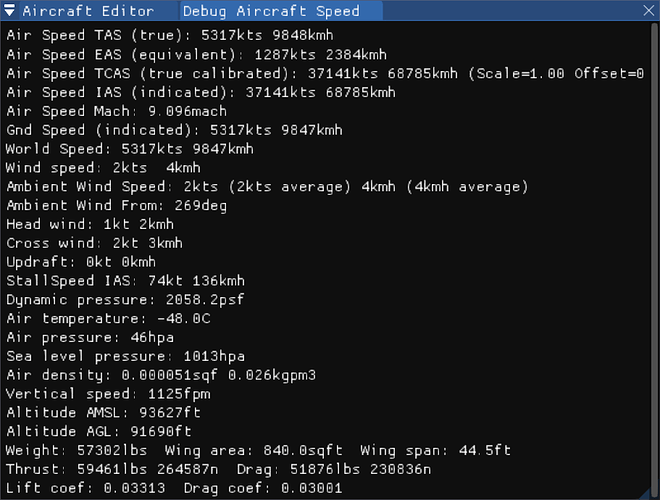Do you have any add-ons in your Community folder? If yes, please remove and retest before posting.
This problem exists for all aircraft in game, both default and community aircraft, but is only notable in aircraft that can approach or exceed the speed of sound at higher altitudes (above 30,000 feet). This will affect upcoming Asobo products like the F/A-18E model slated for release this fall and the hypersonic vehicle that was teased along with it.
Are you using Developer Mode or made changes in it?
To test this issue, yes.
Brief description of the issue:
Indicated airspeed is no longer accurate, in particular at near sonic and supersonic speeds. Indicated Airspeed appears to have been substituted for some sort of modified Calibrated Airspeed (TCAS), which becomes increasingly inaccurate as altitude and Mach number increase. Additionally, this value is now exactly the same as the CAS and IAS, which in the real world is not the case. More problematic, if any developer, including Asobo, were to develop hypersonic performance aircraft, the airspeed calculation is EXTREMELY divergent from expected correct values. At Mach 9 and 90,000 feet, the airspeed reading approaches 40,000 knots, which is far in excess of the True airspeed of 5300 knots and certainly the Indicated airspeed (which using real world calculations should be 780 knots). This speed is actually in excess of orbital velocity, so is clearly calculating incorrectly.
Provide Screenshot(s)/video(s) of the issue encountered:
Detail steps to reproduce the issue encountered:
Place any aircraft capable of supersonic or hypersonic speed at an altitude above 30,000 feet and increase speed to transonic, supersonic, or hypersonic airspeeds. Compared to real world charts and calculations, the returned airspeed on the gauge, which should be based on IAS, is not accurate and will make any attempt to pilot using IAS (for example, monitoring the Never Exceed Speed of a high performance aircraft) impossible. Aircraft don’t use CAS (and in particular whatever has been calculated to be this TCAS value) for the base line speed reference. These use IAS.
PC specs for those who want to assist (if not entered in your profile)
Build Version # when you first started experiencing this issue:
SU5
Are you on the Steam or Microsoft Store version?
Microsoft Store.
Did you submit this to Zendesk? If so, what is your ticket #?
No.





